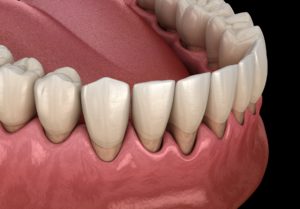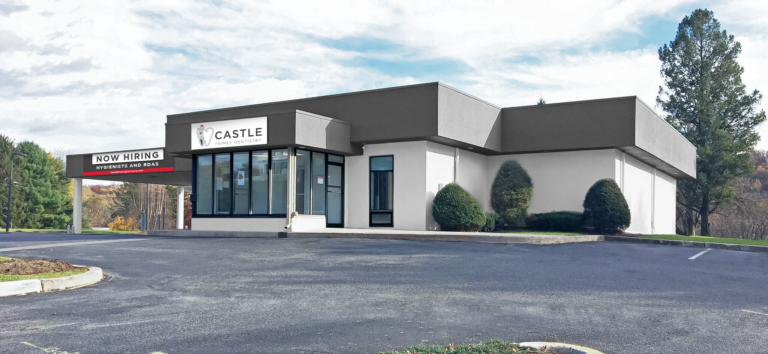Washington, NJ Gum Disease Treatment
Gum disease is a serious condition that affects people from all walks of life. Castle Family Dentistry provides gum disease treatment for all stages of gum disease to prevent future damage and restore your oral health.
Gum Disease Treatment in Washington, NJ
Periodontal disease, periodontitis, and gum disease are all terms used to describe an infection in the gums and bone surrounding your teeth. Healthy gums and bone structures help keep a tooth's root intact. However, when food and plaque get trapped between the gums and teeth, it can lead to an infection, resulting in gum disease. This serious dental condition affects many people and is caused by bacteria from plaque formations on the teeth.
Gingivitis is an early stage of gum disease and refers to inflammation of the gums. Common symptoms of gingivitis include minor redness, swelling, or light bleeding of the gums. If left untreated, gingivitis can turn into a more serious infection known as periodontal disease, which can cause permanent structural damage.
Fortunately, gum disease is preventable. It typically results from poor oral hygiene, such as not flossing and brushing twice a day or not having regular dental checkups. Below, you can find more information about the causes, symptoms, and treatment methods for gum disease.
Periodontal Disease Signs
Periodontal disease is a serious dental condition with severe consequences if left untreated. The earliest sign of periodontitis is an irritated gum line that may bleed or be tender when brushing, flossing, or having your teeth cleaned professionally. If left untreated, the gums will start to recede and pull away from the teeth, creating spaces between the teeth and gums called periodontal pockets. These pockets can quickly become filled with harmful accumulations, leading to the loss of bone and teeth if the condition spreads to the jawbone and connective tissues of teeth.
Some of the most common symptoms of periodontal disease include:
- Gum recession
- “Long teeth”
- Tooth mobility (loose tooth/movement)
- Sore teeth when you chew/bite
- Spaces between teeth
- Deep pockets under your gums
- Visible bone loss on X-rays
- Heavy tartar buildup
- Bad breath
- Bleeding when you brush and floss
- Swollen, red gums
It’s important to note that if you smoke, vape, or use tobacco products, you may not experience the same symptoms as someone who doesn’t. Your tissues could look “healthy” due to the lack of bleeding or swelling, even if the disease is present. That’s why seeing a dental professional regularly is vital to catch and treat any signs of periodontal disease early on.

-
How does a dentist identify gum disease?
Early identification of gum disease is essential to prevent tooth and bone loss. At our clinic, we use the following techniques to determine if you have periodontitis and its severity:
- We review your medical history to identify risk factors that increase the likelihood of gum disease, such as genetics, smoking, or taking certain medications.
- We examine your teeth and gums to check for severe plaque or tartar buildup and bleeding gums, which are both signs of gum disease.
- We measure the depth of your gum pockets by placing a dental probe between your teeth and gums in different areas of your mouth.
- A gum pocket depth of 1-3 mm is considered healthy and normal.
- A depth of 3-5 mm indicates early or mild periodontitis.
- A depth of 5-7 mm indicates moderate periodontitis.
- A depth of 7-10 mm indicates advanced periodontitis.
- We take x-rays of your mouth to check for bone loss in areas with deeper gum pockets.
-
How is periodontal disease or gum disease treated?
Periodontal disease, also known as gum disease, can be treated in two ways, depending on the severity of the condition. The standard treatment for periodontitis is scaling and root planing, which is highly effective in managing the condition in its early to moderate stages. This procedure removes harmful accumulations of plaque, tartar, and oral bacteria from the areas below the gum line and between the teeth. Then, the root surfaces are smoothed out to prevent future accumulations, allowing your gums to begin the healing process and eventually reattach themselves to the teeth.
The second treatment is called bone grafting and is often necessary when bacteria and plaque have damaged the jawbone. In this case, your dentist must surgically access the damaged jawbone to regenerate it by applying proteins and artificial bone-like material to the areas of decay. This procedure encourages new bone growth and strengthens the jawbone, supporting dental implants to replace missing teeth.
-
What causes gum disease?
Three main factors can cause gum disease. The most common one is chronic periodontitis, which is caused by poor oral hygiene, accumulating bacteria beneath the gum line, which eventually hardens into tartar. Tartar is difficult to remove through brushing and flossing and requires professional cleaning. If left untreated, this condition can cause inflammation, damage to the gums, and even bone loss. The second cause is aggressive periodontitis, which is believed to have a genetic component and can show up in families. This condition progresses rapidly and can even affect children. Finally, necrotizing periodontal disease is the rarest cause and can occur in individuals with immune issues or chronic diseases. This condition causes a lack of blood flow to the affected area, compromising the soft tissues and bone.
-
What is gum recession?
Gum recession is a common dental problem affecting approximately half of all Americans over 50. However, young people can also experience gum recession. Genetics can play a role in gum recession, as some people are born with thin gums. Additionally, environmental factors such as aggressive brushing, trauma, surgery, or ill-fitting partials can also contribute to the condition.
If you notice that your tooth looks more prolonged than usual or experience sensitivity or pain while brushing and flossing, you may have gum recession. In this case, it’s essential to consult a dentist so that they can examine the affected area. If gum recession is diagnosed, a minor surgical procedure can be performed to graft a small amount of skin from your palate and patch it over the affected area. This treatment helps to protect the tooth from further damage. Depending on the severity of the condition, this procedure can be done for a single tooth or multiple teeth.
Questions About Periodontal Disease?
Our goal is to provide quality, compassionate, and affordable dental care. If you thing you have gum disease schedule an appointment right away, contact our office if you have any questions, or explore all of the dental services we provide.
Schedule Appointment Contact Our Office See All Dental Services
